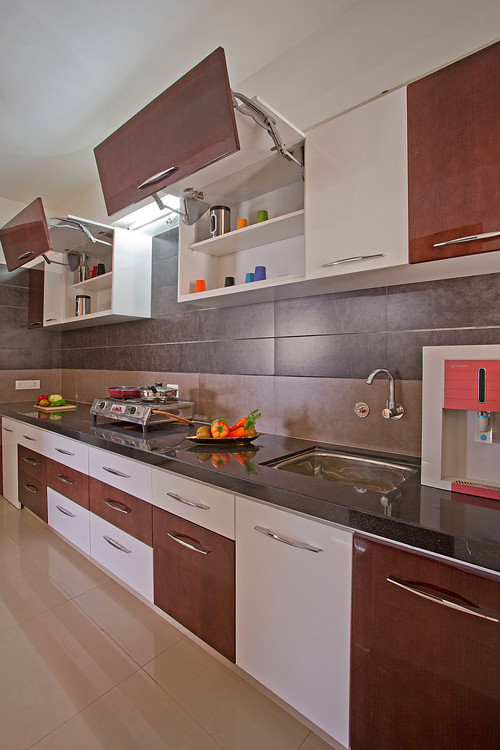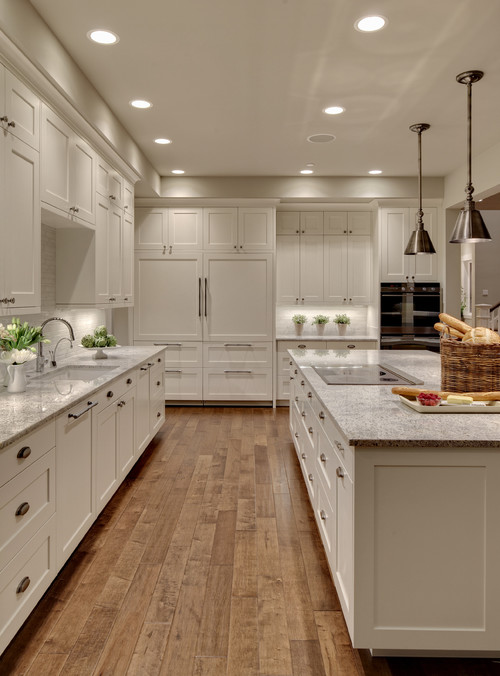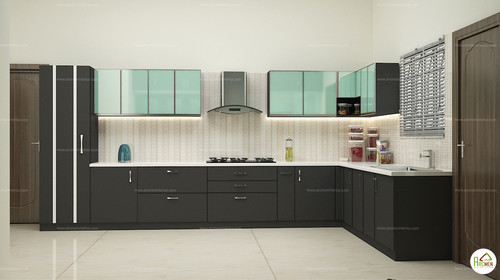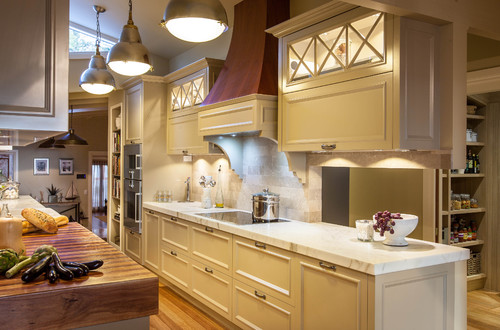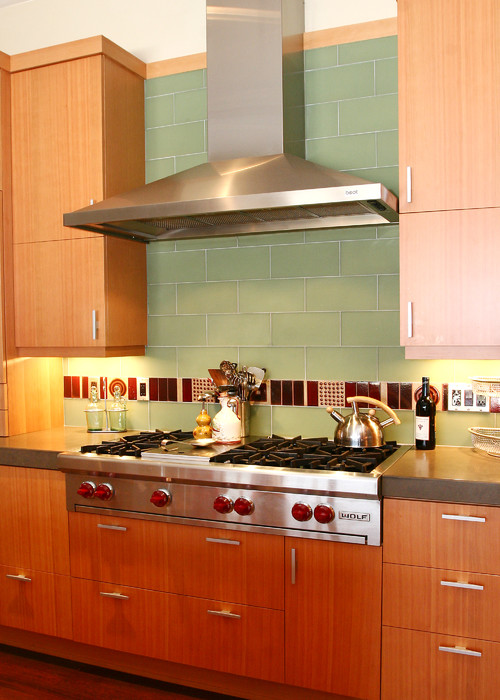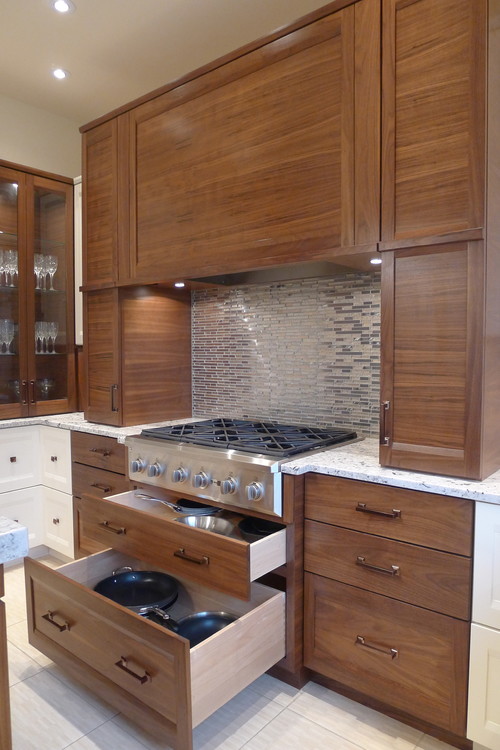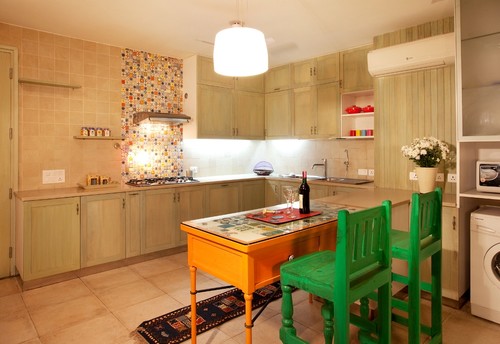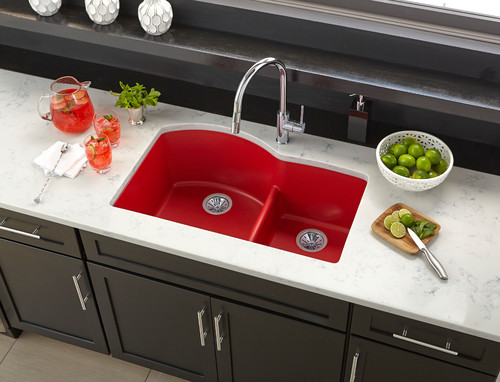The kitchen has a special place in all Indian homes. It is like the stomach of the house that satisfies the soul of the inhabitants. To be able to fulfil its function effectively, it becomes pertinent that the kitchen is designed properly. Dimensions play a major role in the swift functioning of a kitchen. A layperson might wonder about the specific dimensions that should be kept in mind while conceptualising a kitchen. There is an array of dimensions that are at play in a kitchen, but to relieve you of all the confusion, the following are the 8 standard kitchen measurements that you must know when designing your dream kitchen –
1. Height and Depth of the Countertop
A countertop is an element that is the most used in the kitchen, hence knowing about its standard measurements becomes rather important. Though there are standard dimensions for the countertop based on the average human height, there could be slight variations depending on the average height of the household. The height and depth of the countertop are important factors, as these dimensions determine the comfort of the user while working in the kitchen. The height should be such that the user doesn’t strain their back while preparing and cooking the meals. The depth should be adequate to aid in easy working as well as the accommodation of the appliances in the kitchen. These are critical aspects of kitchen counter height standards that support better usability.
According to the standards, the height of the countertop is 850 to 900 mm and the standard depth of the countertop is – 600 mm. For an island countertop (an option that must be considered in the case of large kitchens), the ideal dimensions are 1200 x 900 mm, to accommodate ease of working.
2. Kitchen aisle Width
The width of the kitchen aisle is one of the most important measurements to keep in mind while designing the kitchen. This is for the simple reason that the aisle sees the most movement in the kitchen. If the aisle has a narrow width, then it becomes difficult for the user to work swiftly and efficiently in the kitchen. Therefore, the minimum aisle width to be considered while designing a kitchen is 1020 mm and can go up to 1200 mm.
The aisle width also comes into play when one has to open the cabinets to keep or take things out of the cabinets. Additionally, if the kitchen has parallel countertops, it is best to keep the aisle width at 1200 mm for easy movement and swift working.
This relates closely to kitchen island spacing requirements and small kitchen layout measurements.
3. Clearance between the Countertop and the Overhead Cabinet
Overhead cabinets help in increasing the storage and working space of the kitchen. But where is it that we install the cabinet? Or, what is the minimum clearance that should be considered between the countertop and the overhead cabinet? The minimum clearance should be 600 mm. This clearance is apt to accommodate the backsplash with minimal wastage during construction. Apart from the backsplash, the clearance gives a visual appeal as well as some breathing space above the countertop.
This aligns with kitchen cabinet measurement tips and is a crucial part of any kitchen remodelling measurement guide.
4. Depth of Overhead Cabinet
While the overhead cabinets reach up to the ceiling level to give a neater appeal to the kitchen interiors, the internal design is based on the requirements of the user. The key dimension to remember when it comes to providing overhead cabinets is the depth of the cabinet. The overall depth of these cabinets should be in the range of 300 to 375 mm.
The reason that the depth of these cabinets is less is to prevent the user from getting their head hurt while working in the kitchen. This dimension helps in recessing the cabinet by a good 300 mm to avoid any mishaps and at the same time gives a rhythmic appeal to the overall kitchen décor. However, if the overhead cabinets are planned over kitchen appliances, then the depth can go up to a maximum of 600 mm or match the depth of the appliance or appliance rack to achieve a clean look.
This follows the standard kitchen dimensions guide and also supports ergonomic kitchen design measurements.
5. Distance between the Hob and the Chimney
One of the most important measurements that one should know while designing a kitchen is the distance between the top of the hob and the bottom of the chimney. This is an important dimension to know as the distance between the two elements can alter the way the fumes are exhaled from the kitchen while cooking. The ideal distance should be in the range of 660 – 750 mm. To maintain the performance of the chimney, one should adhere to this range of dimensions (keeping in line with the clearance measure specified by the chimney seller).
Maintaining the right distance is part of kitchen appliance clearance standards and a vital element in any kitchen remodelling measurement guide.
6. Depth of Kitchen Cabinets
The depth of the under-the-counter cabinets is aligned with the depth of the countertop. These can be receded marginally depending on the requirements of the users. The ideal depth of the under-the-counter cabinets is 600 mm. This is considered a standard in kitchen cabinet measurement tips and is also referenced in any standard kitchen dimensions guide. The dimension is standardized keeping in mind the range of reach of the user comfortably.
7. Kitchen Work Triangle
A kitchen work triangle is a combination of dimensions that should be kept in mind when designing a kitchen. The triangle ensures the smooth working of all kitchen-related functions vis-à-vis preparation, cooking, and washing. This forms the basis of essential kitchen layout dimensions and is highly applicable to small kitchen layout measurements. The rule of thumb is that the perimeter of the kitchen triangle must ideally be 8 m (not more), irrespective of the layout of the kitchen.
Try to get the triangle right, and you will be able to work in the kitchen with ease.
8. Sink Clearance
As important as the sink is to the kitchen, giving a standard clearance on either side is equally important. The clearance adjacent to the sink can be used to keep soiled utensils on one side and the clean on the other, or any permutation and combination that the user wants. This is a common part of any kitchen remodeling measurement guide and follows the principles of ergonomic kitchen design measurements. With the variety of sinks available in the market today, the function of the sink has evolved from a mere element to washing utensils. Depending on the model of the sink chosen, the sink clearance can be considered.
By standards, the measurements to follow for sink clearance are 920 mm on one side and about 450 mm on the other (which is primarily used for draining purposes and can be combined with the draining board of the sinks), depending on the layout of the kitchen. However, if one is short on space, the draining board or the drying rack can be stacked above the sink, too.
The standard measurements aforementioned are the most important, according to me, out of a bunch of standard dimensions. It is important to adhere to the standards as they help in achieving a proportionally dimensioned kitchen, thus making it a well-balanced space without compromising on the functionality of the space. The standards are baseline measurements based on the average human anthropometrics and ergonomics, but can be altered marginally depending on factors like the users, their requirements, and the availability of area for the kitchen space.
These standard measurements will hopefully make the kitchen design journey a little easier for you, but in case of any suggestions, please feel free to post your comments.


